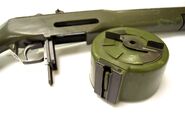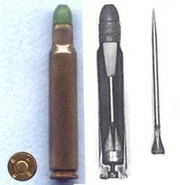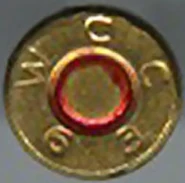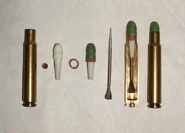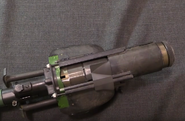The SPIW was an assault rifle designed in collaboration by Winchester and Olin for the Special Purpose Individual Weapon program.
History[]
Four designers made designs for the SPIW program: Harrington & Richardson, AAI, Springfield and Winchester.
Winchester's design was rather innovative; it had a "short recoil" stock, where there was a spring in the stock. This supposedly allowed the rifle to dramatically increase accuracy when firing three round bursts, but it never worked efficiently and the system was dropped. However, the grenade launcher component was found to be rather interesting and work continued on that portion. The system was later integrated with the Springfield design to little success. Two prototypes are now in the collections of the Cody Firearms Museum.[1]
Design Details[]
The SPIW has a conventional-style stock made of polymer. It features a three-lugged rotating bolt with a short-stroke gas tappet. It features a two-phase "soft recoil system", which comprises a second housing inside the action. The bolt and recoiling elements reciprocate into the housing and with it into the stock, to soften the recoil before the bolt hits the back of the receiver and transmit the recoil force into the shooter. However, it was not effective in its intended purpose. The charging handle is on the right-hand side of the rifle. The bolt is also in place with the barrel, so when the charging lever is pulled, the barrel reciprocates with the bolt.
The magazine release lever uses the trigger guard as a flat spring. The trigger guard can also be rotated out of the way for users who are wearing gloves.
The weapon also features a three-position selector lever for three different firing modes on the left-hand side of it; Single-shot (1), three-round burst (3), and fully automatic fire (FA). The rifle fires in open bolt mode in the burst and full-auto modes, while it fires with the bolt closed in single-shot mode. This, however, made the lever finicky. The rifle also features a manual safety on top.
Behind the manual safety is a button, which, when held down while pulling the trigger, allows the user to fire a grenade.
The rifle has a commercial rear sight that is adapted with a new aperture, with a standard "shark fin" sight at the front.
It also has a pivoting sighting system up to 400 meters for the grenade launcher component on the left-hand side of the weapon ahead of the selector lever.
The rifle also had a BAR bipod on the front of it, in order to fulfill the requirement for a detachable bipod.
The SPIW features a recoil-operated, 40mm blow forward grenade launcher mounted at the front of it, developed by Olin[2]. The grenade launcher uses a blow forward barrel sleeve inside of its receiver and had a spring-loaded feed ramp. It has two feedways for grenades, one on either side of the receiver. The loading process, is that the barrel is slid forward, popping open the feed ramp. From there, the user loads a grenade from either one of the two feedways before lifting the feed ramp, causing the barrel to slide back, placing the grenade into the chamber. The user can also load in two additional grenades. This allows the grenade launcher to achieve the three-round capacity requirement for the area-effect weapon element of the rifle. When the grenade launcher is fired, and depending on the munition used, the barrel would either stay in place and/or move forward by the friction of the projectile moving down the barrel while the rest of the rifle is pushed backwards from the recoil, resulting in the barrel cycling forward.
The goal of making a modern grenade launcher was a leftover from Project NIBLICK before it combined with the APHHW (All-Purpose Hand-Held Weapon) program and evolved into the SPIW program with the goal of combining a flechette firing rifle with a grenade launcher.
Ammunition[]
The rifle fired the 5.6×44mm XM144 flechette round. The grenade launcher fires 40mm grenades.
Gallery[]
See also[]
- Special Purpose Individual Weapon
- Flechette
- 5.6×44mm XM144
- Project NIBLICK
- AAI SPIW
- Springfield Armory SPIW
- H&R SPIW
External Links[]
- The Firearm Blog Winchester SPIW showcase
- Forgotten Weapons video: Winchester 1964 SPIW
- Forgotten Weapons article: Winchester 1964 SPIW
- PDF on SPIW modes of fire
- Forgotten Weapons SPIW magazine article
- PDF on Winchester SPIW grenade launcher
- Wikipedia article on SPIW
References[]
| ||||||||||||||||||||||||||






